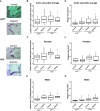Sex-Specific Effects of Prenatal and Early Life Inorganic and Methylated Arsenic Exposure on Atherosclerotic Plaque Development and Composition in Adult Mice
- PMID: 34014776
- PMCID: PMC8136521
- DOI: 10.1289/EHP8171
Sex-Specific Effects of Prenatal and Early Life Inorganic and Methylated Arsenic Exposure on Atherosclerotic Plaque Development and Composition in Adult Mice
Abstract
Background: Epidemiologic studies indicate that early life arsenic exposures are linked to an increased risk of cardiovascular diseases. Different oxidation and methylation states of arsenic exist in the environment and are formed in vivo via the action of arsenic ( oxidation state) methyltransferase (As3MT). Methylated arsenicals are pro-atherogenic postnatally, but pre- and perinatal effects are unclear. This is particularly important because methylated arsenicals are known to cross the placenta.
Objectives: We tested the effects of early life exposure to inorganic and methylated arsenicals on atherosclerotic plaque formation and its composition in apolipoprotein E knock-out () mice and evaluated whether mice lacking As3MT expression were susceptible to this effect.
Methods: We exposed or mice to inorganic or methylated arsenic in the drinking water from conception to weaning and assessed atherosclerotic plaques in the offspring at 18 wk of age. Mixed regression models were used to estimate the mean difference in each outcome relative to controls, adjusting for sex and including a random effects term to account for within-litter clustering.
Results: Early life exposure to inorganic arsenic, and more profoundly methylated arsenicals, resulted in significantly larger plaques in the aortic arch and sinus in both sexes. Lipid levels in these plaques were higher without a substantial difference in macrophage numbers. Smooth muscle cell content was not altered, but collagen content was lower. Importantly, there were sex-specific differences in these observations, where males had higher lipids and lower collagen in the plaque, but females did not. In mice lacking As3MT, arsenic did not alter the plaque size, although the size was highly variable. In addition, control mice had significantly larger plaque size compared with control .
Conclusion: This study shows that early life exposure to inorganic and methylated arsenicals is pro-atherogenic with sex-specific differences in plaque composition and a potential role for As3MT in mice. https://doi.org/10.1289/EHP8171.
Figures






Similar articles
-
Effects of Inorganic Arsenic, Methylated Arsenicals, and Arsenobetaine on Atherosclerosis in the Mouse Model and the Role of As3mt-Mediated Methylation.Environ Health Perspect. 2017 Jul 5;125(7):077001. doi: 10.1289/EHP806. Environ Health Perspect. 2017. PMID: 28728140 Free PMC article.
-
Formation of methylated oxyarsenicals and thioarsenicals in wild-type and arsenic (+3 oxidation state) methyltransferase knockout mice exposed to arsenate.Anal Bioanal Chem. 2013 Feb;405(6):1885-91. doi: 10.1007/s00216-012-6207-0. Epub 2012 Jun 26. Anal Bioanal Chem. 2013. PMID: 22733250
-
Oxidation state specific analysis of arsenic species in tissues of wild-type and arsenic (+3 oxidation state) methyltransferase-knockout mice.J Environ Sci (China). 2016 Nov;49:104-112. doi: 10.1016/j.jes.2016.06.018. Epub 2016 Jul 18. J Environ Sci (China). 2016. PMID: 28007165 Free PMC article.
-
Role of arsenic (+3 oxidation state) methyltransferase in arsenic metabolism and toxicity.Biol Pharm Bull. 2012;35(11):1870-5. doi: 10.1248/bpb.b212015. Biol Pharm Bull. 2012. PMID: 23123458 Review.
-
Arsenic (+3 oxidation state) methyltransferase and the methylation of arsenicals.Exp Biol Med (Maywood). 2007 Jan;232(1):3-13. Exp Biol Med (Maywood). 2007. PMID: 17202581 Free PMC article. Review.
Cited by
-
Arsenic Exposure, Blood DNA Methylation, and Cardiovascular Disease.Circ Res. 2022 Jul 8;131(2):e51-e69. doi: 10.1161/CIRCRESAHA.122.320991. Epub 2022 Jun 6. Circ Res. 2022. PMID: 35658476 Free PMC article.
-
Overview of the cardiovascular effects of environmental metals: New preclinical and clinical insights.Toxicol Appl Pharmacol. 2022 Nov 1;454:116247. doi: 10.1016/j.taap.2022.116247. Epub 2022 Sep 17. Toxicol Appl Pharmacol. 2022. PMID: 36122736 Free PMC article.
-
Altered cord blood mitochondrial DNA content and prenatal exposure to arsenic metabolites in low-arsenic areas.Res Sq [Preprint]. 2023 Oct 31:rs.3.rs-3414865. doi: 10.21203/rs.3.rs-3414865/v1. Res Sq. 2023. PMID: 37961501 Free PMC article. Preprint.
-
Sex-specific transcriptomic effects of low-dose inorganic arsenic exposure on bone marrow-derived macrophages.Toxicology. 2025 Jan;510:153988. doi: 10.1016/j.tox.2024.153988. Epub 2024 Nov 6. Toxicology. 2025. PMID: 39515575
-
2-Hydroxypropyl-beta-cyclodextrin Treatment Does Not Induce Atherosclerotic Lesion Regression in Western-Type Diet-Fed Apolipoprotein E Knockout Mice.Biomolecules. 2022 Aug 31;12(9):1205. doi: 10.3390/biom12091205. Biomolecules. 2022. PMID: 36139044 Free PMC article.
References
-
- ATSDR (Agency for Toxic Substances and Disease Registry). 2007. Toxicological Profile for Arsenic. Atlanta, GA: U.S. Department of Health and Human Services, Public Health Service. 2007. https://stacks.cdc.gov/view/cdc/11481 [accessed 16 April 2021].
-
- Balakrishnan P, Vaidya D, Franceschini N, Voruganti VS, Gribble MO, Haack K, et al. . 2017. Association of cardiometabolic genes with arsenic metabolism biomarkers in American Indian communities: the Strong Heart Family Study (SHFS). Environ Health Perspect 125(1):15–22, PMID: 27352405, 10.1289/EHP251. - DOI - PMC - PubMed
-
- Bates D, Maechler M, Bolker B, Walker S. 2014a. lme4: linear mixed-effects models using Eigen and S4. Version 1.1-7.
Publication types
MeSH terms
Substances
Grants and funding
LinkOut - more resources
Full Text Sources
Other Literature Sources
Medical
Miscellaneous

